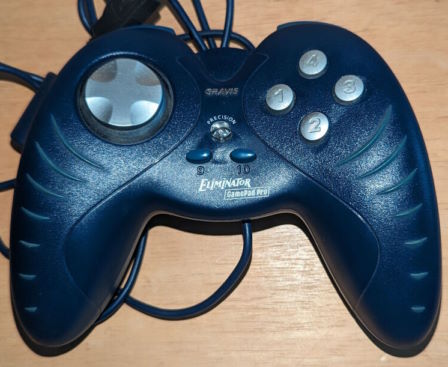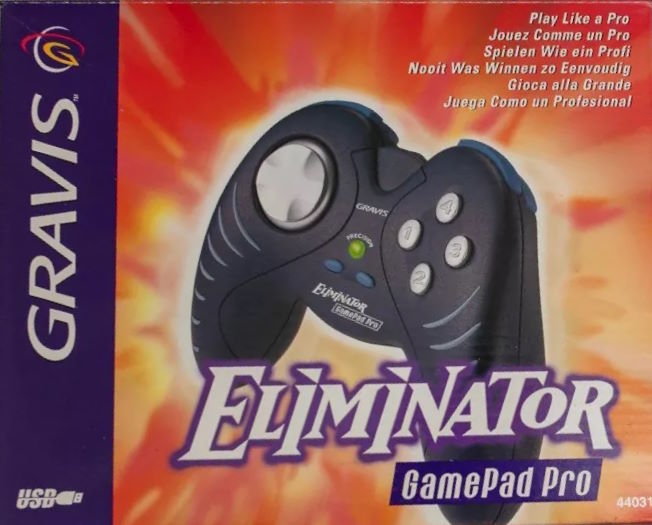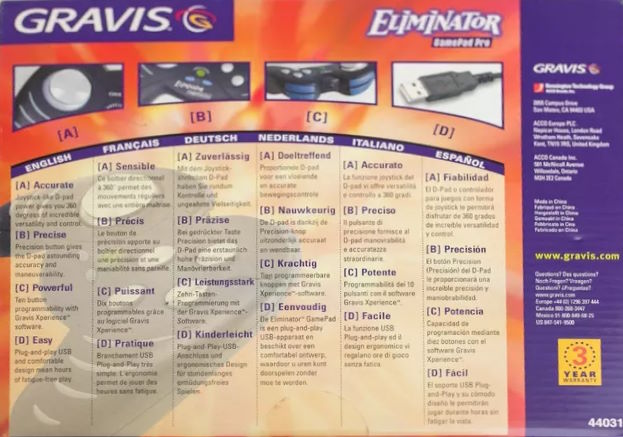Tales from storage: Gravis gamepad grumbling
Back before it got revamped (however many revamps ago that was…!), the Games I Own section really was about having something to say about every possession I owned, from DVDs to action figures to video game controllers. Gamepads are fascinating to me, if having a blog tag dedicated to the things weren’t already a clue.
If I ever need a bit of frivolous and unwarranted retail therapy, I often think: why don’t I treat myself to a nice new controller? Having a different doohickey to wrap my paws around is a neat way of experiencing the same games in a new light, whether it’s trying to play Metal Slug on a flight stick, or running through Sonic Adventure on a d-pad. Look, I didn’t say it was a good use of my time, but sometimes you just want to scratch a silly itch.

At one point picking up controllers for the express purpose of reviewing them was something I wanted to do, and I can only imagine that’s why I came into possession of the Gravis Eliminator Gamepad Pro (it’s easier to accept that than remember how dour the USB gamepad market was at the turn of the millennium).
I, uh, don’t know what this controller is trying to accomplish though. Gravis were seemingly a big name in the early days of PC gamepads, at least when it came to wares that were inspired by console controllers, designed with platformers and arcade games in mind… however many of these there were at the time. So why on earth is this secretly an analogue joystick?!

Not a joke, not a jape: rather than 8-directional hat switches, the cross-shape is on top of a dome with 360 degrees of analogue sensitivity, with seemingly no means of, like, not doing that. That GIF above isn’t the character laboriously building up speed, that’s me slowly moving the “d-pad” to the rim. Crazy Chicken: The Good, The Egg & The Ugly bizarrely supports analogue sensitivity, allowing you to make Moorhuhn carefully inch forward, despite his breakneck running animation. That’s two oddities right there!
The controller was released circa 2002, so I guess 3D games with greater nuance of control were becoming more common on PC… but why like this? On all other accounts it’s a solid little controller. Its tapered shape is pretty pleasant to hold, the curve of the shoulder buttons and its superfluous ridges making for satisfying hand-feel, and its 10 buttons all function very nicely, of satisfying shape and build quality. (kudos for using hard plastic on the Start and Select stand-ins; the soft material used on the 8BitDo SN30 Pro is mushy and prone to not registering)


(images from andrewkendall)
But the wonky stick is anything but ideal for 2D games, and the wide face for its stick actually renders precise, sensitive movement a hassle to perform, despite the back of the box describing its “joystick-like D-pad” as “accurate”. Without a second stick, it’s useless for first-person shooters (unless you still use the mouse to aim, which guilty of doing on occasion), and 3D platformers were quickly moving away from shoulder buttons for camera control, making it no good there either. It’s not a worthless controller, it’s just a design that’s hard to fight in its corner…!
I have no memory of Gravis as a recognisable brand; Wikipedia says they were bought out by Kensington at some point, which is a reminder what an odd little cottage industry computer accessories were throughout the ’90s into the early ’00s. All those “ergonomic” keyboards and unorthodox alternatives to using the mouse, products lining the shelves of PC World that led me to believe they were the gateway to a whole new realm of productivity… but were almost assuredly just plastic guff banking on impressionable schmucks.


(images from bessoh_4663 and emmaszone)
Gravis’ initial wares were very much copying what consoles had to offer; the Grip Pad literally just a Mega Drive controller, the GamePad Pro mimicking the original PlayStation model… while the Exterminator Force could almost be compared to a surrealist Sega Saturn controller, an unexpected homage to Salvador Dali. The Eliminator Shock is seemingly the closest they got to a traditional twin-stick controller, though with an unusual high placement for both sticks that puts the buttons and d-pad on the bottom, the inverse of the PS2 format.
I think the Xbox 360 making its controller the standard for PC gaming quashed the need for these bizarre also-rans, and though we’re better off for it, there’s something to be said for just how unorthodox some of these are. It does feel like controllers and peripherals are a rich man’s game now, with the rise of companies producing high-end remakes of classic controllers, or even the likes of VR being extremely dependent on their specialist hardware.
It’d be nice if 3D printing advanced to such a stage where printing not just controller casings, but even their circuit boards was feasible — both to ‘preserve’ some of these old designs, but I also think it’d make a fun party game. Gamepad roulette! Though the hippie in me fusses over the waste involved, and wishes recycling these things were also feasible. Imagine what good all those Wii Remote accessories or Guitar Hero instruments could do instead of clogging up cupboards…!

Speaking of recycling, I had a bad habit years ago of picking up old 9-pin controllers off eBay with the intent of converting them to USB… though my interest tanked the moment I realised, oh, you don’t convert those connectors so much as you just swap the circuit board for a USB compatible one. Buying USB gamepads for the purpose of gutting them just felt cruel, especially when they played fine as-is…!
Looking up the Gravis stuff, part of me was almost tempted to make a column out of reviewing them, but I think that endeavour had a very finite audience and appeal, even to myself. Leave that to the gaming YouTubers with ad revenue to burn, not the dopes who don’t know how to relax and enjoy themselves.
